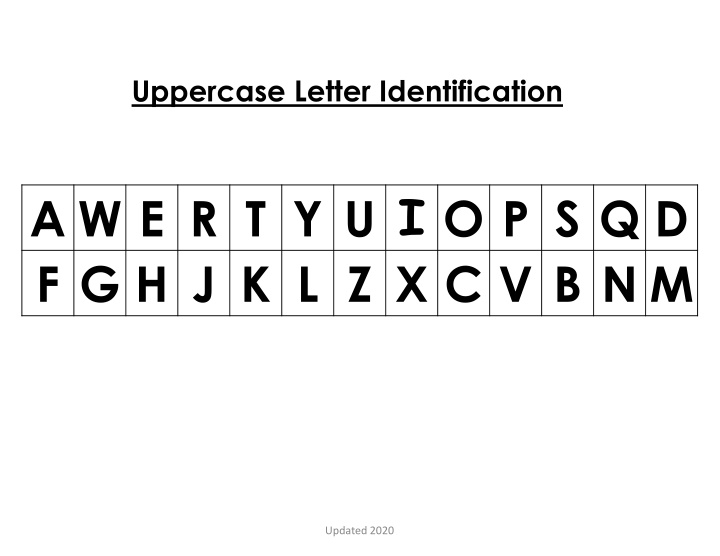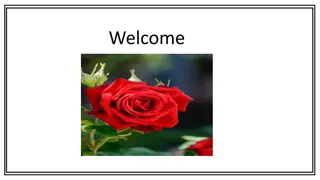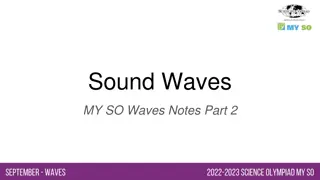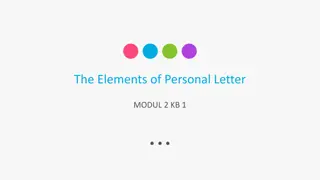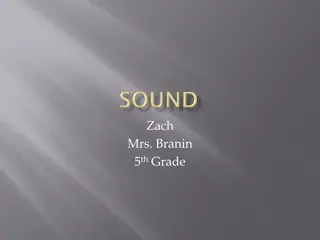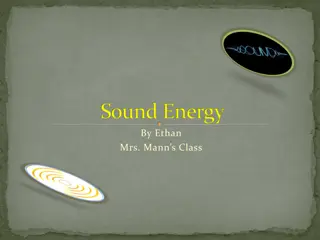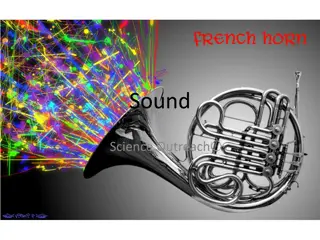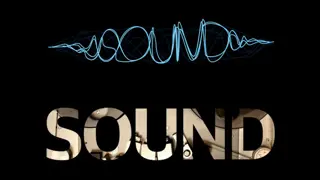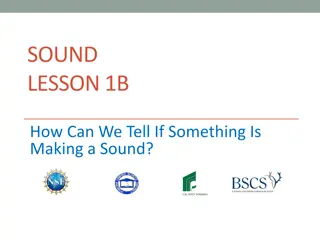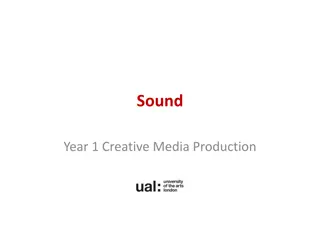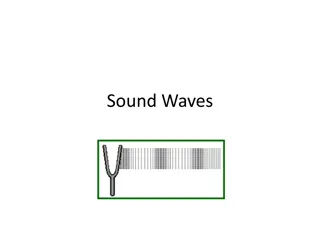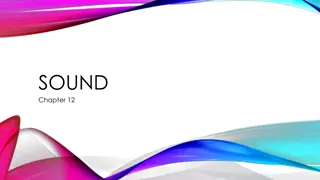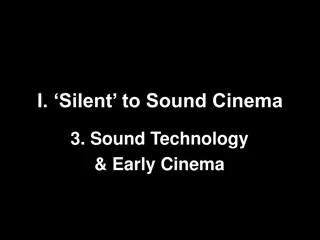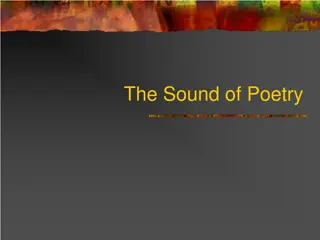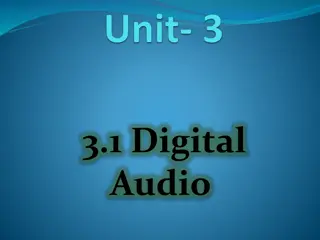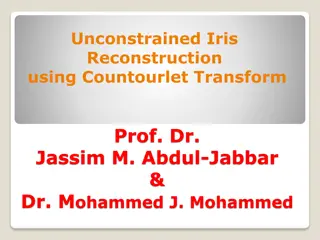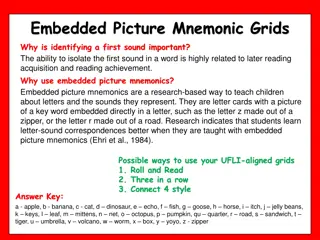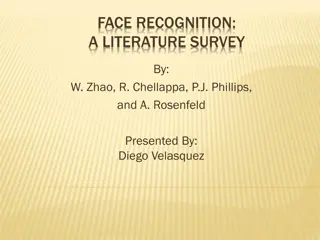Letter Identification and Sound Recognition Activities
This collection includes uppercase and lowercase letter identification images, along with suggested pre-assessments and sound identification activities for the 1st 9 weeks. The materials aim to enhance students' ability to recognize letters, their corresponding sounds, and blend spoken words for phonological understanding in language development. The resources are designed for teachers to assess and reinforce foundational literacy skills in an engaging and effective manner.
Download Presentation

Please find below an Image/Link to download the presentation.
The content on the website is provided AS IS for your information and personal use only. It may not be sold, licensed, or shared on other websites without obtaining consent from the author.If you encounter any issues during the download, it is possible that the publisher has removed the file from their server.
You are allowed to download the files provided on this website for personal or commercial use, subject to the condition that they are used lawfully. All files are the property of their respective owners.
The content on the website is provided AS IS for your information and personal use only. It may not be sold, licensed, or shared on other websites without obtaining consent from the author.
E N D
Presentation Transcript
Uppercase Letter Identification A W E R T Y U I O P S Q D F G H J K L Z X C V B N M Updated 2020
Suggested Pre-assessment: 1st 9 weeks Directions Letters will be presented in random order. Student should touch and name each letter. The goal is 1 letter per second to show automaticity. Rationale Students should be able to identify letter names and corresponding sounds before moving forward on the phonics continuum. This skill is NOT assessed for report card and 1st grade standards purposes but is important knowledge for moving forward with instruction. Updated 2020
Lowercase Letter Identification p o i u y t r e w q l k j h g f d s a m n b v c x z Updated 2020
Suggested Pre-assessment: 1st 9 weeks Directions Letters will be presented in random order. Student should touch and name each letter. The goal is 1 letter per second to show automaticity. Rationale Students should be able to identify letter names and corresponding sounds before moving forward on the phonics continuum. This skill is NOT assessed for report card and 1st grade standards purposes but is important knowledge for moving forward with instruction Updated 2020
Sound Identification s d f a g h j k l q w e r t y u i o p z x c v b n m Updated 2020
Suggested Pre-assessment: 1st 9 weeks Directions Letters will be presented in random order. Student should touch and name each letter sound. The goal is 1 letter sound per second to show automaticity. Rationale Students should be able to identify letter names and corresponding sounds before moving forward on the phonics continuum. This skill is NOT assessed for report card and 1st grade standards purposes but is important knowledge for moving forward with instruction Updated 2020
Suggested assessment: 1st 9 Weeks Directions Teacher says: /b/ /eat/ /b/ /end/ /k/ /air/ /g/ /aim/ /p/ /itch/ Student responds: beat bend care game pitch State Standard (phonological) Report Card Language Students will blend and segment onset and rime in spoken words (e.g., /ch/ + /at/= chat) Student will blend onset and rime in spoken words. 1. Can only complete with guidance and support. 2. Can complete independently most of the time. 3 out of 5 correct 3. Students will blend onset and rime in spoken words. 4 out of 5 correct 4. N/A Updated 2020
Suggested assessment: ONLY IF STUDENTS DID NOT SCORE A 3 IN THE PREVIOUS 9 WEEKS. Directions: Alternative Words for blending onset and rime in spoken words. 2nd 9 Weeks 3rd 9 Weeks 4th 9 Weeks /f/ /air/ /m/ /ask/ /l/ /and/ /s/ /eat/ /r/ /ice/ fair mask land seat rice /s/ /igh/ /l/ /ow/ /p/ /ie/ /f/ /arm/ /l/ /ake/ sigh low pie farm lake /sh/ /ow/ /b/ /eat/ /p/ /aw/ /c/ /atch/ /l/ /ay/ show beat paw catch lay Updated 2020
Suggested assessment: 1st 9 Weeks Directions Teacher says: fate say bake toe kneel Student responds: /f/ /ate/ /s/ /ay/ /b/ /ake/ /t/ /oe/ /kn/ /eel/ State Standard (phonological) Report Card Language Students willblendand segment onset and rime in spoken words (e.g., /ch/ + /at/= chat) Student will segment onset and rime in spoken words. 1. Can only complete with guidance and support. 2. Can complete independently most of the time. 3 out of 5 correct 3. Students will segment onset and rime in spoken words. 4 out of 5 correct 4. N/A Updated 2020
Suggested assessment: ONLY IF STUDENTS DID NOT SCORE A 3 IN THE PREVIOUS 9 WEEKS. Directions: Alternative Words for segmenting onset and rime in spoken words. 2nd 9 Weeks 3rd 9 Weeks 4th 9 Weeks peel bay tie now nice /p/ /eel/ /b/ /ay/ /t/ /ie/ /n/ /ow/ /n/ /ice/ lake chop high lamp jump /l/ /ake/ /ch/ /op/ /h/ /igh/ /l/ /amp/ /j/ /ump/ match meat toad kite cone /m/ /atch/ /m/ /eat/ /t/ /oad/ /k/ /ite/ /c/ /one/ Updated 2020
Suggested assessment: 3rd 9 Weeks Directions Teacher reads word list. Student responds with long vowel or short vowel . way bite lap crib boat cute mop beat pest club State Standard (phonological) Report Card Language Students will recognize the short or long vowel sound in one syllable words. 1. Can only complete with guidance and support. 2. Can identify the vowel sound but cannot distinguish between long and short.5, 6, or 7 out of 10 correct. 3. Students will differentiate short from long vowel sounds in one syllable words. 8 out of 10 correct. 4. N/A Updated 2020 Students will differentiate short from long vowel sounds in one syllable words.
Suggested assessment: ONLY IF STUDENTS DID NOT SCORE A 3 IN THE PREVIOUS 9 WEEKS. Directions: Alternative Words for segmenting onset and rime in spoken words. 2nd 9 Weeks 3rd 9 Weeks 4th 9 Weeks rain bat rug six right top rope need tune bed wig cane ten home sight fox nut cube cap green leg road mop stay bean sit bag rug hike tube Updated 2020
Suggested assessment: 1st 9 weeks Directions: Teacher will say a word telling students to listen for either the initial, medial or final sound. Student will repeat the word and then say either the initial, medial or final sound. Example: I m going to say a word, /box/. Now you say the word /box/. What is the first sound in the word box?Student should say /b/. Initial (Beginning) Medial (Middle) Final (End) house pay apple nose sun /h/ /p/ /a/ /n/ /s/ tip crop tub scan web /i/ /o/ /u/ /a/ /e/ coat ship pass drag crib /t/ /p/ /s/ /g/ /b/ State Standard (phonological) Report Card Language Students will isolate and pronounce the initial, medial and final sounds in spoken words. Student can isolate all three sound positions in spoken words. 1. Can only isolate one of three sound positions in spoken words. 2. Can isolate two of three sound positions in spoken words with less than 80% mastery. 3. Can isolate all three sound positions in spoken words with 100% mastery. 4. N/A Updated 2020
Suggested assessment: ONLY IF STUDENTS DID NOT SCORE A 3 IN THE PREVIOUS 9 WEEKS. Directions: Teacher will say a word telling students to listen for either the initial, medial or final sound. Student will repeat the word and then say either the initial, medial or final sound. Example: I m going to say a word, /box/. Now you say the word /box/. What is the first sound in the word box? Student should say /b/. 2nd, 3rd, and 4th 9 weeks Initial (Beginning) Medial (Middle) Final (End) pond dime cast book list /p/ /d/ /c/ /b/ /l/ wet cap hut doll plain /e/ /a/ /u/ /o/ /ai/ last bring fox pass think /t/ /g/ /x/ /s/ /k/ Initial (Beginning) Medial (Middle) Final (End) fast lay mend night rainbow /f/ /l/ /m/ /n/ /r/ bug six tape pen drop /u/ /i/ /a/-long a /e/ /o/ smell green trim sheep farm /l/ /n/ /m/ /p/ /m/ Initial (Beginning) Medial (Middle) Final (End) pumpkin gave favorite donut sailboat /p/ /g/ /f/ /d/ /s/ cub lip sled tap road /u/ /i/ /e/ /a/ /o/-long o stop load dream lock shave /p/ /d/ /m/ /k/ /v/ Updated 2020
Suggested assessment: 1st 9 Weeks Directions: Teacher will say the phonemes in the word and the student will blend phonemes to say the word. Example: I m going to say some sounds, /b/ /o/ /x/. What is this word? Student says /box/. /b/ /l/ /o/ /ck/ /g/ /r/ /a/ /ss/ /t/ /r/ /i/ /p/ /s/ /c/ /a/ /n/ /d/ /y/ /s/ /t/ /a/ /ck/ block grass trips candy stack State Standard (phonological) Report Card Language Students will blend phonemes to form spoken words with 4 to 6 phonemes including consonant blends. (e.g., /s/ /t/ /r/ /i/ /ng/ =string) Blend phonemes to form spoken words including consonant blends. 1. Can blend phonemes with guidance and support. 2. Can blend 2 to 3 phonemes including consonant blends to form spoken words. 3. Students will blend phonemes to form spoken words with 4 to 6 phonemes including consonant blends. 4. N/A Updated 2020
Suggested assessment: ONLY IF STUDENTS DID NOT SCORE A 3 IN THE PREVIOUS 9 WEEKS. Directions: Teacher will say the phonemes in the word and the student will blend phonemes to say the word. Example: I m going to say some sounds, /b/ /o/ /x/. What is this word? Student says /box/. 2nd 9 Weeks 3rd 9 Weeks 4th 9 Weeks /j/ /u/ /m/ /p/ /g/ /e/ /n/ /t/ /le/ /s/ /n/ /ai/ /l/ /t/ /e/ /n/ /t/ /s/ /p/ /oo/ /n/ jump gentle snail tent spoon /l/ /i/ /m/ /i/ /t/ /s/ /l/ /ee/ /p/ /b/ /r/ /oo/ /m/ /s/ /p/ /u/ /d/ /b/ /e/ /s/ /t/ limit sleep broom spud best /t/ /w/ /i/ /n/ /n/ /e/ /s/ /t/ /c/ /l/ /o/ /ck/ /f/ /r/ /o/ /g/ /s/ /p/ /e/ /ll/ twin nest clock frog spell Updated 2020
Suggested assessment: 1st 9 Weeks Directions: Teacher will say the phonemes in the word and the student will blend phonemes to say the word. Example: I m going to say a word, box. What are all the sounds you hear in the word box? Student says, /b/ /o/ /x/. crisp thump bloom task mend /c/ /r/ /i/ /s/ /p/ /th/ /u/ /m/ /p/ /b/ /l/ /oo/ /m/ /t/ /a/ /s/ /k/ /m/ /e/ /n/ /d/ State Standard (phonological) Report Card Language Students will segment phonemes to form spoken words with 4 to 6 phonemes into individual phonemes. (e.g., string=/s/ /t/ /r/ /i/ /ng/) Students will segment phonemes in spoken words including consonant blends. 1. Can segment phonemes with guidance and support. 2. Can segment 2 to 3 phonemes including consonant blends to form spoken words. 3. Students will segment phonemes in spoken words with 4 to 6 phonemes including consonant blends. 4. N/A Updated 2020
Suggested assessment: ONLY IF STUDENTS DID NOT SCORE A 3 IN THE PREVIOUS 9 WEEKS. Directions: Teacher will say the phonemes in the word and the student will blend phonemes to say the word. Example: I m going to say a word, box. What are all the sounds you hear in the word box? Student says, /b/ /o/ /x/. 2nd 9 Weeks 3rd 9 Weeks 4th 9 Weeks trash flip most splint cream /t/ /r/ /a/ /sh/ /f/ /l/ /i/ /p/ /m/ /o/ /s/ /t/ /s/ /p/ /l/ /i/ /n/ /t/ /c/ /r/ /ea/ /m/ stone climb grinch grip plants /s/ /t/ /o/ /n/ /c/ /l/ /i/ /m/ /g/ /r/ /i/ /n/ /ch/ /g/ r/ /i/ /p/ /p/ /l/ /a/ /n/ /t/ /s/ glide shrub blade stamp frost /g/ /l/ /i/ /d/ /sh/ /r/ /u/ /b/ /b/ /l/ /a/ /d/ /s/ /t/ /a/ /m/ /p/ /f/ /r/ /o/ /s/ /t/ Updated 2020
Suggested assessment: 1st 9 Weeks Directions: Example: Teacher says: I m going to say a word part, at. Repeat the word part, (at). Now say at with /b/ at the beginning. Student says, bat. start with phoneme to add completed word am end odd and egg /j/ /m/ /n/ /l/ /p/ jam mend nod land peg State Standard (phonological) Report Card Language Students can add phonemes to form spoken words. e.g., add /g/ to the beginning of low to say glow Can add phonemes to form spoken words. 1. Can add phonemes in spoken words with guidance and support. 2. Can add phonemes in spoken words most of the time. 3 out of 5 correct 3. Can add phonemes to form spoken words. 4 out of 5 correct 4. N/A Updated 2020
Suggested assessment: ONLY IF STUDENTS DID NOT SCORE A 3 IN THE PREVIOUS 9 WEEKS. Directions: Example: Teacher says: I m going to say a word part, at. Repeat the word, (at). Now say at with /b/ at the beginning. Student says, bat. start with phoneme to add completed word an it in all am /p/ /k/ /ch/ /m/ /h/ pan kit chin mall ham 2nd 9 Weeks start with phoneme to add completed word ock id ay ug et /s/ /d/ /p/ /r/ /w/ sock did pay rug wet 3rd 9 Weeks start with phoneme to add completed word og all ip or um /d/ /st/ /ch/ /sn/ /h/ dog stall chip snore hum 4th 9 Weeks Updated 2020
Suggested assessment: 1st 9 Weeks Directions: Example: Teacher says: I m going to say a word, boot. You say the word, (boot). Now say boot without the /t/. Student says, boo. start with phoneme to delete completed word team sight fork mail feet /m/ /t/ /k/ /l/ /t/ tea sigh for may fee State Standard (phonological) Report Card Language Students can delete phonemes to form spoken words. e.g., remove the /t/ from boot , to say boo Can delete phonemes to form spoken words. 1. Can delete phonemes in spoken words with guidance and support. 2. Can delete phonemes in spoken words most of the time. 3 out of 5 correct 3. Can delete phonemes to form spoken words. 4 out of 5 correct 4. N/A Updated 2020
Suggested assessment: ONLY IF STUDENTS DID NOT SCORE A 3 IN THE PREVIOUS 9 WEEKS. Directions: Example: Teacher says: I m going to say a word, boot. You say the word, (boot). Now say boot without the /t/. Student says, boo. start with phoneme to delete completed word might wait sheep heed guest /t/ /t/ /p/ /d/ /t/ my way she he guess 2nd 9 Weeks start with phoneme to delete completed word night tide great tense soap /t/ /d/ /t/ /s/ /p/ nigh tie gray ten so 3rd 9 Weeks start with phoneme to delete completed word sight week seem lawn stork /t/ /k/ /m/ /n/ /k/ sigh we see law store 4th 9 Weeks Updated 2020
Suggested assessment: 1st 9 Weeks Directions: Example: Teacher says: I m going to say a word, charm. You say the word, (charm). Now change the /ch/ in charm to /f/. Student says, farm. start with phoneme to change completed word not bake man hip sick /n/ to /h/ /b/ to /l/ /m/ to /c/ /h/ to /s/ /s/ to /t/ hot lake can sip tick State Standard (phonological) Report Card Language Students can substitute phonemes to form spoken words. e.g., change the /ch/ in charm to /f/ to say farm Can substitute phonemes to form spoken words. 1. Can substitute phonemes in spoken words with guidance and support. 2. Can substitute phonemes in spoken words most of the time. 3 out of 5 correct 3. Can substitute phonemes to form spoken words. 4 out of 5 correct 4. N/A Updated 2020
Suggested assessment: ONLY IF STUDENTS DID NOT SCORE A 3 IN THE PREVIOUS 9 WEEKS. Directions: Example: Teacher says: I m going to say a word, charm. You say the word, (charm). Now change the /ch/ in charm to /f/. Student says, farm. start with phoneme to change completed word sat boom king mop run /s/ to /b/ /b/ to /z/ /k/ to /r/ /o/ to /a/ /u/ to /a/ bat zoom ring map ran 2nd 9 Weeks start with phoneme to change completed word ran milk bell whine cub /a/ to /u/ /m/ to /s/ /b/ to /t/ /wh/ to /sh/ /u/ to /o/ run silk tell shine cob 3rd 9 Weeks start with phoneme to change completed word bent five math pit dance /b/ to /s/ /f/ to /h/ /m/ to /p/ /i/ to /a/ /d/ to /pr/ sent hive path pat prance 4th 9 Weeks Updated 2020
CVC Words bat fox pug zip bus kid pot hen ram jet Updated 2020
Suggested assessment: 2nd 9 Weeks Directions: Teacher has students read list of CVC words. State Standard (phonics and word study) Report Card Language Students will decode CVC words with short vowels Can decode CVC words with fluency. (Student does not need to decode individual sounds.) 1. Can decode with guidance and support. 2. Can decode most of the time, sometimes still saying individual sounds. E.g., /c/ /a/ /t/=cat 6 or 7 out of 10 3. Can decode CVC words with fluency. (Student does not need to decode individual sounds.) 8 or 9 out of 10 4. Can decode CVC words with fluency and ease. 10/10 Updated 2020
Words with Blends still trick fist plant gasp flag clap pond step desk bring grab brunt twig crop Updated 2020
Suggested assessment: 2nd 9 Weeks Directions: Teacher has students read list of words with blends. State Standard (phonics and word study) Report Card Language Students will decode consonant blends with short vowels, initial and final. Can decode consonant blends with short vowels with fluency and ease. 1. Can decode with guidance and support. 2. Can decode blends most of the time, sometimes still saying individual sounds. E.g., /f/ /l/ /a/ /g/=flag 8, 9, 10, or 11 out of 15 3. Can decode consonant blends with short vowels with fluency and ease. 12, 13, or 14 out of 15 4. Can decode consonant blends with short vowels with fluency and ease. 15/15 Updated 2020
Consonant Digraphs and Trigraphs chip with king patch thump speck rock witch lunch duck whip crash shot graph Phil Updated 2020
Suggested assessment: 2nd 9 Weeks Directions: Teacher has students read list of words with consonant digraphs and trigraphs. State Standard (phonics and word study) Report Card Language Students can decode consonant digraphs and trigraphs with short vowels. *wh, ch, ph, sh, ng, th, ck, -tch Can decode consonant digraphs and trigraphs with short vowels with fluency and ease. 1. Can decode with guidance and support. 2. Can decode most of the consonant digraphs and trigraphs. 8, 9, 10, or 11 out of 15 3. Can decode consonant digraphs and trigraphs with fluency and ease. 12, 13, or 14 out of 15 4. Can decode consonant digraph and trigraph words with fluency and ease. 15/15 Updated 2020
Silent-e made cube skate Pete hike time poke dime hope tune Updated 2020
Suggested assessment: 2nd 9 Weeks Directions: Teacher has students read list of words with silent-e. State Standard (phonics and word study) Report Card Language Students will decode with silent-e. Can decode with silent-e with fluency and ease. 1. Can decode with guidance and support. 2. Can decode most words with silent-e. 6 or 7 out of 10 3. Can decode with silent-e words with fluency and ease. 8 or 9 out of 10 4. Can decode silent-e words with fluency and ease. 10/10 Updated 2020
Long Vowels-Vowel Pairs book play real pie show mail toast moon train sleep feet snow float pool tie Updated 2020
Suggested assessment: 2nd 9 Weeks Directions: Teacher has students read list of words with long vowels, including vowel pairs. State Standard (phonics and word study) Report Card Language Students will decode long vowels, including vowel pairs. Can decode with long vowels with fluency and ease. 1. Can decode with guidance and support. 2. Can decode most words with long vowels. 8, 9, 10, or 11 out of 15 3. Can decode with long vowels with fluency and ease. 12, 13, or 14 out of 15 4. Can decode long vowel words with fluency and ease. 15/15 Updated 2020
R-Controlled Vowels farm her girl storm turn dirt card border hurt whisper Updated 2020
Suggested assessment: 2nd 9 Weeks Directions: Teacher has students read list of words with r-controlled vowels. State Standard (phonics and word study) Report Card Language Students will decode words with r-controlled vowels. Can decode r-controlled vowels. 1. Can decode with guidance and support. 2. Can decode most words with r-controlled vowels. 6 or 7 out of 10 3. Can decode words with r-controlled vowels. 8 or 9 out of 10 4. Can decode words with r-controlled vowels with fluency and ease. 10/10 Updated 2020
Variant Vowels coin crawl frown pause few spoil boy shout mouth cow saw drew fault toy glue Updated 2020
Suggested assessment: 2nd 9 Weeks Directions: Teacher has students read list of words with variant vowels. State Standard (phonics and word study) Report Card Language Students will decode words with variant vowels. Can decode words with variant vowels. 1. Can decode with guidance and support. 2. Can decode most words with variant vowel patterns. 8, 9, 10, or 11 out of 15 3. Can decode words with variant vowel patterns. 12, 13, or 14 out of 15 4. Can decode words with variant vowel patterns with fluency and ease. 15/15 Updated 2020
Inflectional Ending standing stomped sticks tricked flashed jobs kicking jumping planted hops Updated 2020
Suggested assessment: 2nd 9 Weeks Directions: Teacher has students read list of words with inflectional endings. State Standard (phonics and word study) Report Card Language Students will decode words with inflectional endings. Can decode inflectional endings. 1. Can decode with guidance and support. 2. Can decode most of the time but does not self correct. 3. Can decode words with inflectional endings. May self-correct. 4. Can decode words with inflectional endings without self-correction. Updated 2020
Suggested assessment: All 9 Weeks Directions Teacher will assess this skill through writing assignments given throughout the 9 weeks. State Standard (writing) Report Card Language Students will correctly form letters and us appropriate spacing for letters, words, and sentences using left-to-right and top-to- bottom progression. Students will form letters correctly and use appropriate spacing. 1. 2. 3. Not all letters are formed correctly and/or lack of correct spacing. Most letters are formed correctly and spacing is correct some of the time. Students will form letters correctly and use appropriate spacing. Updated 2020
Suggested assessment: All 9 Weeks Directions Teacher will assess this skill through spelling assessments given throughout the 9 weeks. Teacher will assess this skill through Wonders high frequency words. Teacher will assess this skill through Wonders Fluency Assessment Book. State Standard (writing) Report Card Language Students will correctly spell grade appropriate, highly decodable words (e.g., cup, like, cart) and common, irregularly spelled sight words (e.g., the) Students will correctly spell spelling words from Wonders. Students will read high frequency and/or common irregularly spelled grade level words with automaticity in text. Students will correctly read high frequency words from Wonders. Students will orally read grade level text at an appropriate rate, smoothly and accurately, with expression that connotes comprehension. Students will read at a rate of: 2nd 9 weeks-23 words correct per minute 3rd 9 weeks-38 words correct per minute 4th 9 weeks-53 words correct per minute *use the passages in the Wonders Fluency Assessment Book Updated 2020
Suggested assessment: All 9 Weeks Directions Teacher chooses familiar story out of the Wonders curriculum. (Can be a shared reading.) Ask the student to retell the story focusing on details and main idea. *The same story can be used to assess details, main idea, sequencing, point of view and textual evidence. State Standard (reading) Report Card Language Students will retell or reenact major events in a text, focusing on important details to recognize the main idea. Retell events in a text focusing on details and main idea. 1. 2. 3. 4. Can only provide limited and/or unrelated details. Can provide details, but main idea is lacking. Retell events in a text focusing on details and main idea. Can retell with strong details, main idea and sequential order. Updated 2020
Suggested assessment: 2rd 9 Weeks Directions Teacher may choose to read aloud a familiar story or have student read the text and then provide the sequence of events for that story. (Can be a shared reading.) **The same story can be used to assess details, main idea, sequencing, point of view and textual evidence. State Standard (reading) Report Card Language Students will sequence the events/plot (i.e., beginning, middle, and end) of a story or text. Sequence the events of a selected story. 1. 2. 3. 4. Cannot recall any events of a story. Can recall events but cannot sequence the events. Can recall and sequence the events. (Beginning, Middle and End) Can recall, sequence and add meaningful details. Updated 2020
Suggested assessment: 2rd 9 Weeks Directions Teacher may choose to read aloud a familiar story or have student read the text and then provide the sequence of events for that story. (Can be a shared reading.) *The same story can be used to assess details, main idea, sequencing, point of view and textual evidence. State Standard (reading) Report Card Language Students will describe who is telling the story (i.e., point of view). Students will describe who is telling the story. 1. 2. 3. 4. Unable to describe who is telling the story. Able to describe who is telling the story with guidance and support. Can describe who is telling the story. Can describe who is telling the story and provide evidence. Updated 2020
